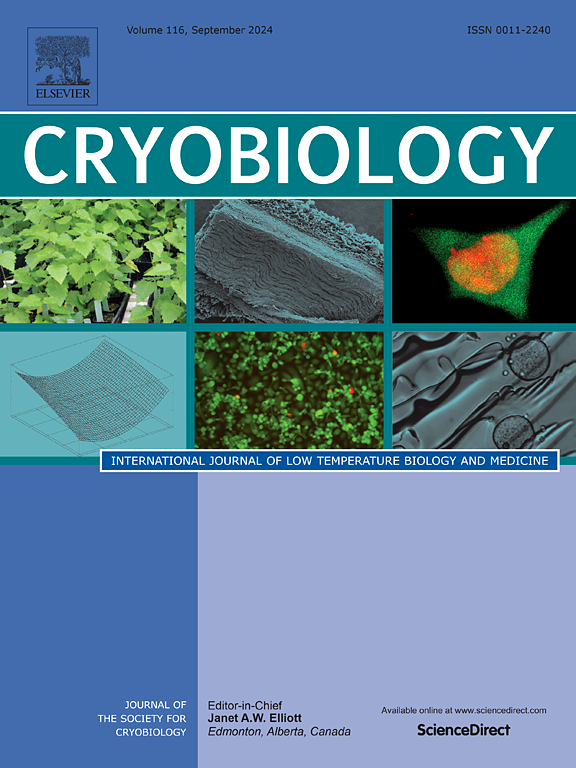High-throughput evaluation of cryoprotective agents for mixture effects that reduce toxicity
IF 2.1
3区 生物学
Q2 BIOLOGY
引用次数: 0
Abstract
Vitrification is a promising approach for cryopreserving complex biological structures such as organs. However, to prevent ice formation, high concentrations of cell-permeable cryoprotective agents (CPAs) are required, which can be highly toxic. The current reliance on a small number of CPAs limits optimization of low-toxicity compositions for vitrification. To address this, there is growing interest in uncovering novel chemicals with analogous protective qualities. This may not only enhance vitrification efficacy but also mitigate toxic effects. In the current study, we employed a high throughput method to assess the toxicity of 21 compounds at room temperature, both individually and in binary combinations, using bovine pulmonary artery endothelial cells (BPAEC) as a model system. Our analysis revealed that toxicity increases with both exposure duration and concentration, and that several CPA combinations result in reduced overall toxicity. Notably, among all tested mixtures, four binary combinations—formamide/glycerol, dimethyl sulfoxide/1,3-propanediol, 1,2-propanediol/diethylene glycol, and 1,3-propanediol/diethylene glycol—produced a statistically significant decrease in toxicity, resulting in significantly higher viability for the 6 mol/kg mixture than both corresponding 6 mol/kg single CPA solutions. The high-throughput approach presented here will aid in building a comprehensive CPA toxicity database, which will improve our understanding of toxicity mechanisms and support the development of predictive models for identifying novel CPA mixtures with low toxicity.
降低毒性的混合冷冻保护剂的高通量评价。
玻璃化是冷冻保存复杂生物结构(如器官)的一种很有前途的方法。然而,为了防止冰的形成,需要高浓度的细胞渗透性冷冻保护剂(CPAs),这可能是剧毒的。目前对少量cpa的依赖限制了玻璃化低毒性组合物的优化。为了解决这个问题,人们对发现具有类似保护特性的新型化学物质越来越感兴趣。这不仅可以提高玻璃化效果,还可以减轻毒性作用。在本研究中,我们采用高通量方法,以牛肺动脉内皮细胞(BPAEC)为模型系统,评估了21种化合物在室温下的毒性,包括单独和二元组合。我们的分析显示,毒性随暴露时间和浓度的增加而增加,并且几种CPA组合导致总体毒性降低。值得注意的是,在所有测试的混合物中,四种二元组合——甲酰胺/甘油、二甲基亚砜/1,3-丙二醇、1,2-丙二醇/二甘醇和1,3-丙二醇/二甘醇——产生的毒性显著降低,导致6 mol/kg混合物的活力明显高于相应的6 mol/kg单一CPA溶液。本文提出的高通量方法将有助于建立一个全面的CPA毒性数据库,这将提高我们对毒性机制的理解,并支持开发预测模型,以识别具有低毒性的新型CPA混合物。
本文章由计算机程序翻译,如有差异,请以英文原文为准。
求助全文
约1分钟内获得全文
求助全文
来源期刊

Cryobiology
生物-生理学
CiteScore
5.40
自引率
7.40%
发文量
71
审稿时长
56 days
期刊介绍:
Cryobiology: International Journal of Low Temperature Biology and Medicine publishes research articles on all aspects of low temperature biology and medicine.
Research Areas include:
• Cryoprotective additives and their pharmacological actions
• Cryosurgery
• Freeze-drying
• Freezing
• Frost hardiness in plants
• Hibernation
• Hypothermia
• Medical applications of reduced temperature
• Perfusion of organs
• All pertinent methodologies
Cryobiology is the official journal of the Society for Cryobiology.
 求助内容:
求助内容: 应助结果提醒方式:
应助结果提醒方式:


